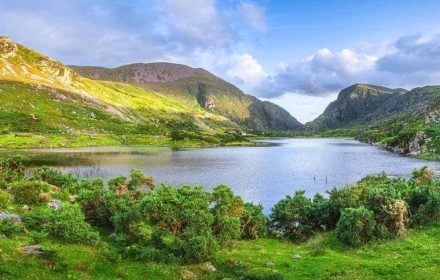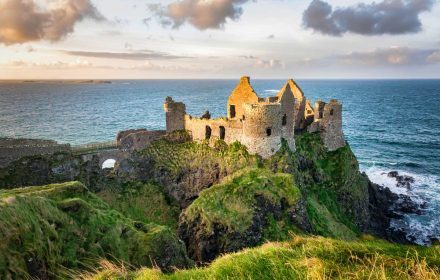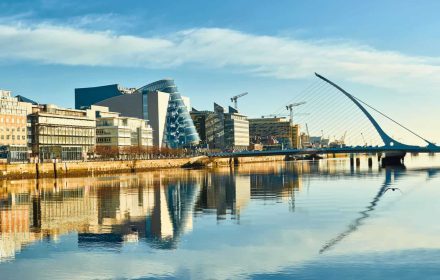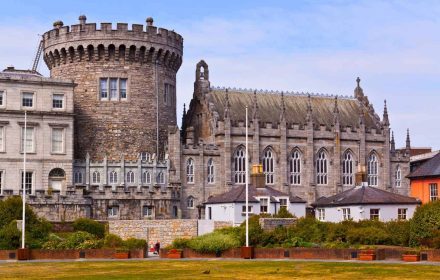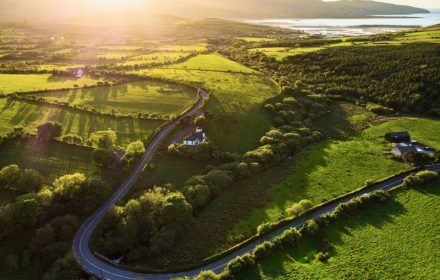This site uses affiliate links, meaning that if you make a purchase through our links, we may earn an affiliate commission.
Explore the Ring of Kerry, a renowned scenic route in County Kerry, known for its stunning landscapes and rich heritage.
This guide showcases the best stops along the way, with detailed maps and must-see attractions at each stop allowing you to make the most of your journey through this iconic Irish destination.
- 1. The Ring of Kerry Drive: Practical Details and Route Options
- 2. Map with 22 Best Stops on the Ring of Kerry Drive
- 3. Best Stops on the Ring of Kerry Drive
-
- 3.1. Ross Castle
- 3.2. Muckross Abbey
- 3.3. Torc Waterfall
- 3.4. Ladies View
- 3.5. Moll's Gap
- 3.6. Kenmare Stone Circle
- 3.7. Dunkerron Castle
- 3.8. Sneem
- 3.9. Staigue Stone Fort
- 3.10. Castlecove Beach
- 3.11. Catherdaniel Stone Fort
- 3.12. Derrynane House, Beach and Abbey
- 3.13. Waterville Beach
- 3.14. Ballinskelligs Beach, Abbey and Castle
- 3.15. The Kerry Cliffs
- 3.16. Portmagee
- 3.17. Valentia Island
- 3.18. Cahergall Stone Fort
- 3.19. Kells Bay Beach, House, and Gardens
- 3.20. Rossbeigh Bay Beach
- 3.21. Kerry Woollen Mills
- 3.22. The Killarney Brewing and Distilling Company
- 4. Intrepid Scout's Tips for Best Stops on the Ring of Kerry
The Ring of Kerry Drive: Practical Details and Route Options
- Starting and Ending Point: Begin your Ring of Kerry journey from Killarney, the starting and ending point of this route.
Killarney is the traditional place to start and finish, but you can choose any location along the route that fits your plans.
- Length of the Ring of Kerry Drive: The Ring of Kerry covers 179 kilometers (111 miles) and passes through key stops such as Killarney, Kenmare, Sneem, Cahersiveen, Waterville, Glenbeigh, and Killorglin.
- Duration of the Drive: The non-stop drive along the Ring of Kerry route usually takes approximately 2.5 hours.
This blog post outlines all the important stops, giving you the flexibility to choose the ones that interest you the most.
For those with only a single day to explore the Ring of Kerry, prioritizing the highlights is crucial.
INTREPID’S TIP: I suggest referring to my post titled Perfect 1-Day Ring of Kerry Drive Itinerary for a selection of must-see attractions along the route that you can accomplish within one day.
- Recommended Driving Direction: Consider navigating the route in a clockwise direction. This strategic choice minimizes the likelihood of getting stuck behind multiple tour buses, as they typically travel in the opposite direction.
Map with 22 Best Stops on the Ring of Kerry Drive
Map with 22 Best Stops on the Ring of Kerry (click on the map to view it in Google Maps)
Best Stops on the Ring of Kerry Drive
Ross Castle
The first stop on the Ring of Kerry Drive is Ross Castle located near Killarney in Killarney National Park.
Constructed in the late 15th century by the O’Donoghue clan, it stands as a testament to Ireland’s rich medieval heritage.
The castle is situated on the shores of Lough Leane, the largest of the three Lakes of Killarney, providing a picturesque backdrop to its imposing structure.
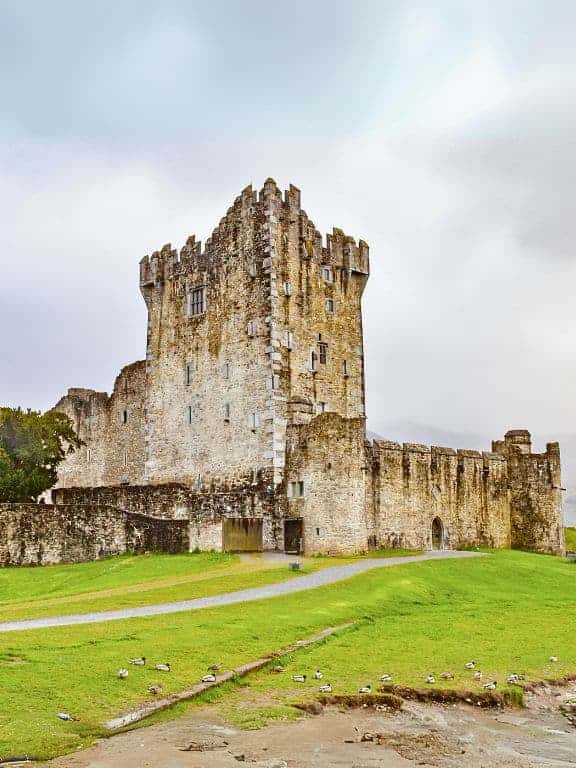
Stop #1 – Ross Castle in Killarney National Park
Originally built as a stronghold, Ross Castle played a significant role in various conflicts throughout its history, including the Desmond Rebellions of the 16th century.
It was also subject to multiple sieges during the Irish Confederate Wars in the mid-17th century. The castle’s strategic location made it a focal point for control over the surrounding region.
GOOD TO KNOW: Ross Castle’s architecture showcases typical features of Irish tower houses of the period, characterized by thick walls, narrow windows, and a defensive tower. The castle underwent renovations and expansions over the centuries, reflecting changes in architectural styles and defensive needs.
Nowadays, Ross Castle offers guided tours that will give you a glimpse into the castle’s storied past.
Muckross Abbey
Mucross Abbey is the second stop on the Ring of Kerry Drive. It is a historic monastery situated within Killarney National Park. Founded in the 15th century, as a Franciscan friary, it is renowned for its Gothic architecture.
One of the most notable features of Muckross Abbey is its impressive cloister, adorned with intricate stone carvings and arches, reflecting the craftsmanship of its medieval builders.
The abbey’s interior houses well-preserved tombs, crosses, and other religious artifacts.
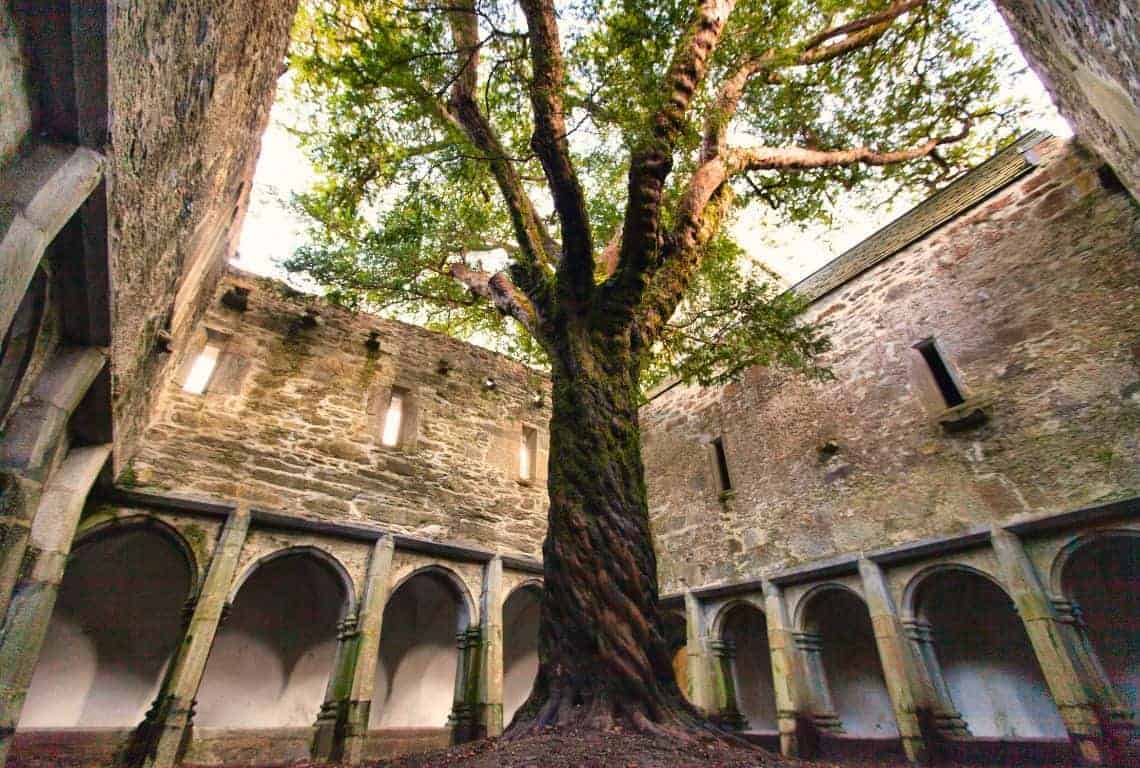
Stop #2 – Cloister at Muckross Abbey
Torc Waterfall
Torc Waterfall is a popular natural attraction in Killarney National Park. It plunges approximately 20 meters (66 feet) over rocks into a pool below, surrounded by lush greenery.
INTREPID’S TIP: There are 2 parking lots. One is located no more than 5 minutes from the waterfall, and the second one is about 25-20 minutes away from the waterfall.
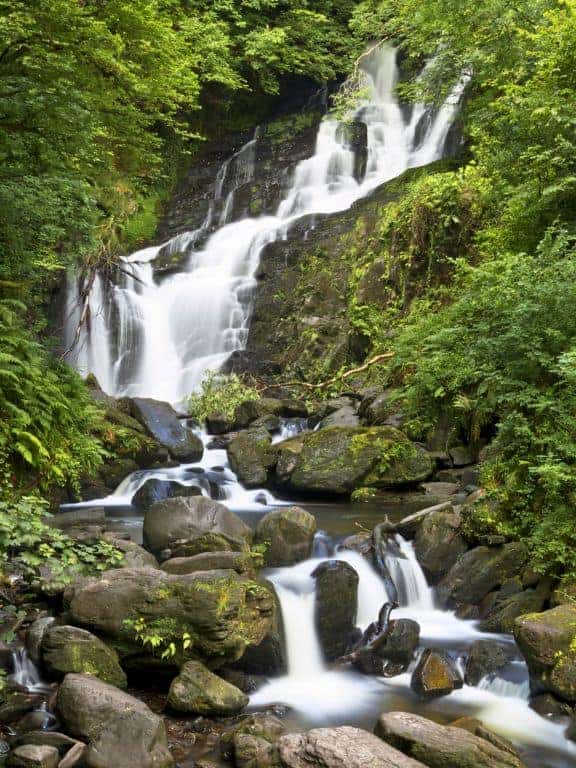
Stop #3 – Beautiful Torc Waterfall in Killarney National Park
GOOD TO KNOW: Torc Waterfall’s name comes from ‘torc,’ Gaelic for wild boar. Legend says a cursed man, turning into a boar by night, lived in a cliff cavern. Discovered by a farmer, he offered riches to keep quiet but vanished in anger, creating the waterfall as he disappeared into a nearby lake.
Ladies View
Ladies View is a renowned scenic viewpoint.
From this vantage point, you are treated to breathtaking panoramic views of the picturesque lakes of Killarney and the majestic mountains that flank them, including McGillycuddy’s Reeks range.
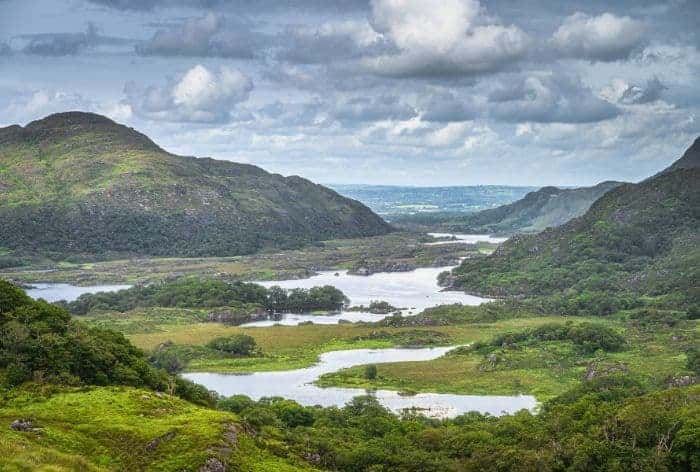
Stop #4 – Stunning Ladies View in Killarney National Park on the Ring of Kerry Drive
GOOD TO KNOW: The name “Ladies View” traces its origins back to the 19th century when Queen Victoria’s ladies-in-waiting were reportedly captivated by the beauty of the vista during their visit.
Moll's Gap
The next stop on the Ring of Kerry Drive is Moll’s Gap. This mountain pass offers impressive views of the surrounding landscapes, including the Macgillycuddy’s Reeks range and the Black Valley.
The name “Moll’s Gap” is believed to come from Moll Kissane, who ran a small shebeen in the area during the 1820s, providing a resting spot for travelers.
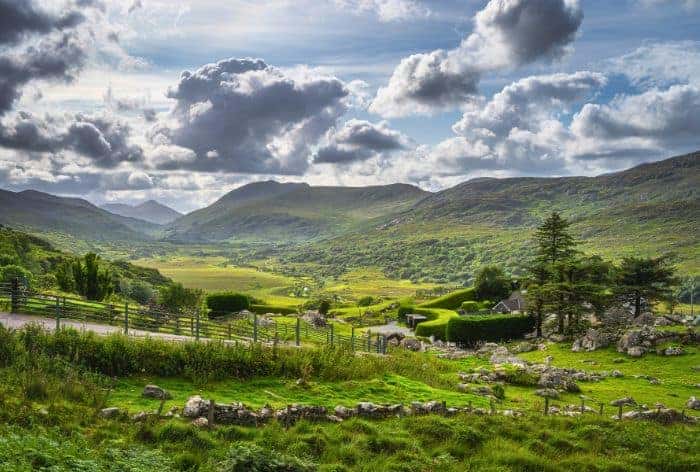
Stop #5 – View from Moll’s Gap
Kenmare Stone Circle
The Kenmare Stone Circle is a prehistoric monument located near the town of Kenmare.
Dating back to the Bronze Age, it is one of the largest stone circles in southwest Ireland and is believed to have been constructed around 2,500 to 2,200 BC.
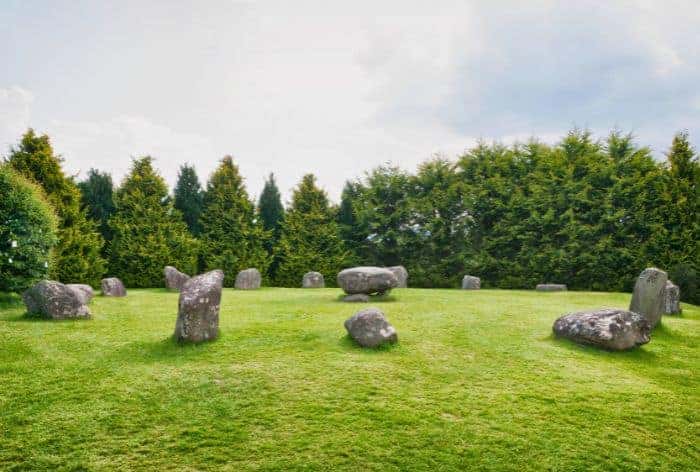
Stop #6 – Kenmare Stone Circle
The stone circle consists of 15 standing stones, with the tallest stone measuring approximately 2.7 meters (9 feet) in height. The stones are arranged in a circular formation, with a diameter of about 17 meters (56 feet).
Archaeological excavations have revealed evidence of cremated human remains and pottery fragments within the circle, suggesting that it was used for ceremonial or religious purposes.
Dunkerron Castle
Next is just a quick stop at Dunkerron Castle. It was constructed in the 15th century. It served as a stronghold for the O’Sullivan clan, a prominent Gaelic Irish family.
The castle overlooks the River Sneem and is built in the traditional Irish tower house style, featuring thick stone walls and defensive features such as narrow windows.
Today, Dunkerron Castle stands as a ruin, with limited access to its interior due to its condition.
Sneem
Sneem is a charming village renowned for its brightly colored buildings that line its streets.
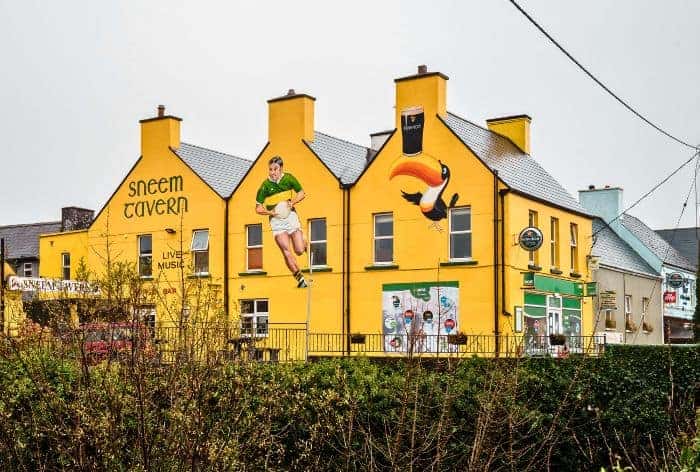
Stop #8 – Charming Village of Sneem
INTREPID’S PRO TIP: Whenever I pass through Sneem, I always stop at The Village Kitchen and enjoy their hearty chowder, delicious classic fish and chips, or freshly baked soda bread. It’s a favorite spot of mine in the village and the service is super friendly.
Staigue Stone Fort
Staigue Stone Fort, located in County Kerry, Ireland, is an ancient circular stone structure dating back to the late Iron Age or early medieval period. It is estimated to have been constructed around 300 to 400 AD.
The fort is built entirely of dry stone masonry, without the use of mortar, showcasing the advanced engineering and construction techniques of its time. Its walls stand approximately 5.5 meters (18 feet) high and are about 4 meters (13 feet) thick.
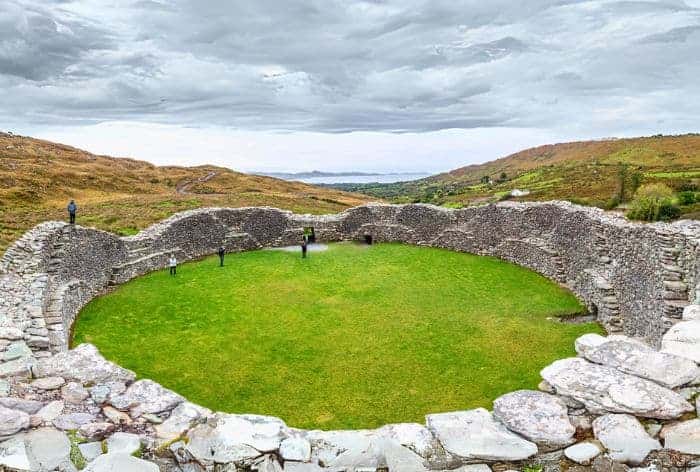
Stop #9 – Staigue Stone Fort
Staigue Stone Fort is one of the largest and best-preserved stone forts in Ireland.
The strategic location of the fort provided its inhabitants with a commanding view of the surrounding landscape, aiding in defense and surveillance.
Castlecove Beach
Our next destination is the serene Castlecove Beach, located near the village of Caherdaniel. Tucked within a sheltered cove, the beach is framed by rugged cliffs and verdant greenery.
I suggest parking at the nearby lot and taking a leisurely stroll down to the shoreline—an ideal opportunity to stretch your legs and enjoy the tranquil surroundings.
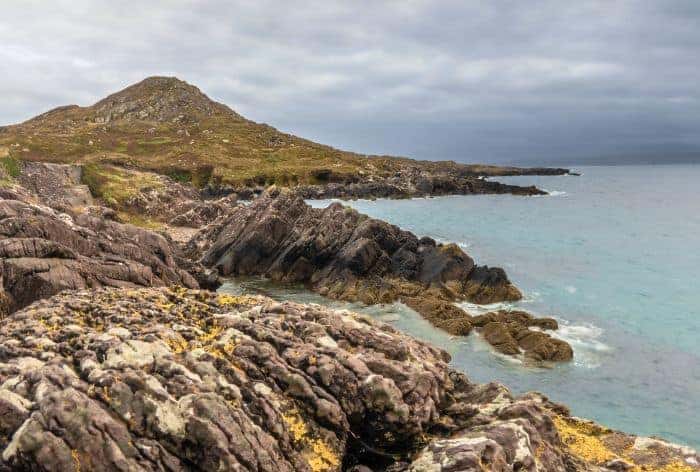
Stop #10 – Castlecove Beach
Catherdaniel Stone Fort
Caherdaniel Stone Fort is an ancient circular stone fort located near the village of Caherdaniel.
It dates back to the early medieval period, estimated to have been constructed around the 9th or 10th century AD. The fort is built entirely of dry stone masonry, without the use of mortar. It consists of concentric circular walls, forming inner and outer enclosures, with the innermost wall enclosing a central courtyard.
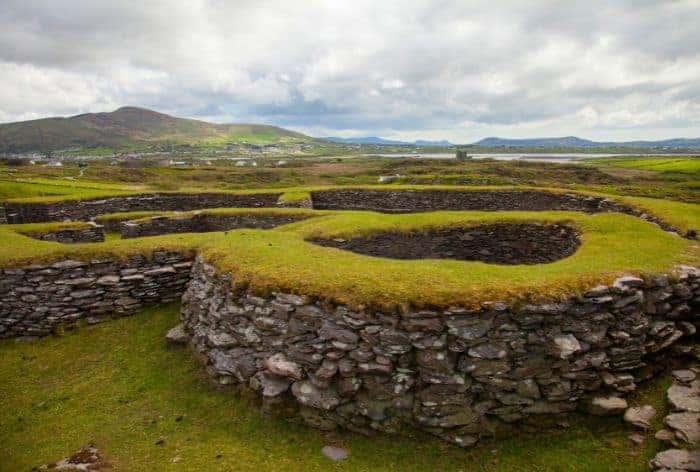
Stop #11 – Catherdaniel Stone Fort
Caherdaniel Stone Fort is believed to have served as a defensive stronghold for its inhabitants, protecting against potential raids or invasions. It is thought to have been the residence of a local chieftain or noble family, with evidence suggesting it was also used for agricultural purposes.
Today, Caherdaniel Stone Fort is a designated national monument of Ireland.
Derrynane House, Beach and Abbey
Derrynane House is a historic Georgian mansion located near Caherdaniel. It was the former residence of Daniel O’Connell, an influential Irish political leader known as “The Liberator.” The house is set amidst beautiful gardens and overlooks Derrynane Bay and the Atlantic Ocean.
Today, it serves as a museum dedicated to O’Connell’s life and political achievements, showcasing period furnishings, artifacts, and memorabilia.
Derrynane Beach is a scenic sandy beach situated near Derrynane House. It is renowned for its crystal-clear waters and picturesque surroundings.
Derrynane Abbey, also known as St. Finian’s Bay Church, is a historic monastery located close to Derrynane House and Beach on Abbey Island. It dates back to the 6th century and is associated with St. Finian, an early Irish Christian saint.
The abbey features ancient stone ruins, including remnants of walls and a Celtic cross, providing insight into Ireland’s early Christian heritage.
GOOD TO KNOW: You can access Derrynane Abbey during the low tide. It is a short walk from Derrynane Beach.
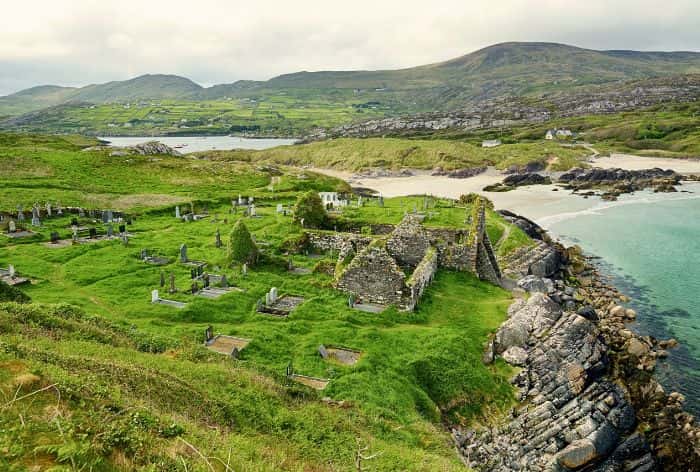
Stop #12 – Derrynane Abbey on Abbey Island
Waterville Beach
Waterville Beach, situated in Waterville, provides extensive views of Ballinskelligs Bay and the Skellig Islands.
If the weather allows, taking a walk on the beach is recommended. It is a perfect spot to stretch your legs and enjoy the scenery.
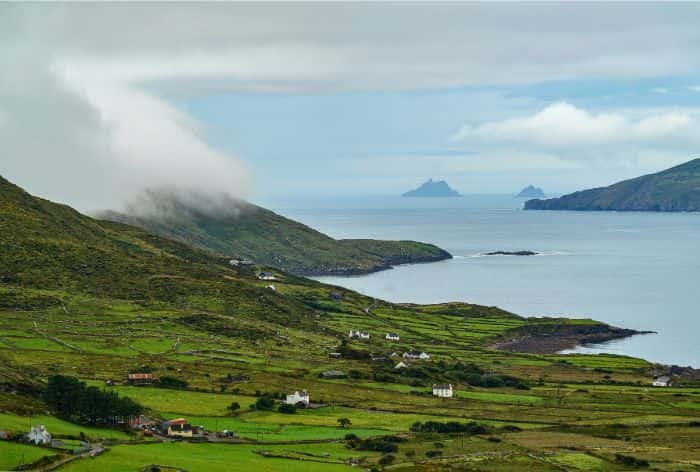
Stop #13 – View of Ballinskelligs Bay and the Skellig Islands
GOOD TO KNOW: Waterville is home to the Charlie Chaplin Statue, which was installed in 1998. This statue honors the renowned actor and filmmaker, Charlie Chaplin, who frequented the area during his leisure time in the 1960s.
Crafted from bronze, the statue captures Chaplin in a serene posture, seated on a bench with a cane in hand, gazing out at the scenic beauty of Ballinskelligs Bay.
Ballinskelligs Beach, Abbey and Castle
Ballinskelligs is a small village located on the Iveragh Peninsula on the Ring of Kerry Drive.
One of the main attractions in Ballinskelligs is its beautiful sandy beach, Ballinskelligs Beach, which stretches along Ballinskelligs Bay. It offers panoramic views of the Atlantic Ocean and nearby Skellig Islands.
The village is also home to the ruins of Ballinskelligs Abbey, a historic monastery dating back to the 12th century. The abbey served as a place of worship and refuge for monks and pilgrims over the centuries, and its well-preserved ruins are a testament to Ireland’s rich religious heritage.
On the western edge of Ballinskelligs Bay sits Ballinskelligs Castle. The castle was built in the 16th century by the MacCarthy Mórs to safeguard the bay against pirate raids.
Additionally, it’s speculated that the castle might have been used to impose tariffs on incoming trade ships.
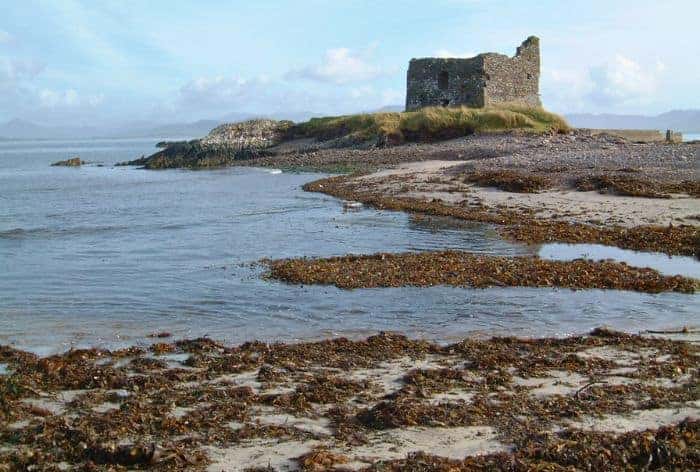
Stop #14 – Ballinskelligs Castle
The Kerry Cliffs
For me, the Kerry Cliffs are the highlight of the Ring of Kerry Drive!
These cliffs, among the most breathtaking in Ireland, offer an unparalleled view of the rugged Skellig Islands and the surrounding countryside.
Formed over 400 million years ago in a desert area, they span over 4 miles and reach a towering height of 1000 feet above sea level, making them one of the tallest cliffs in the country.
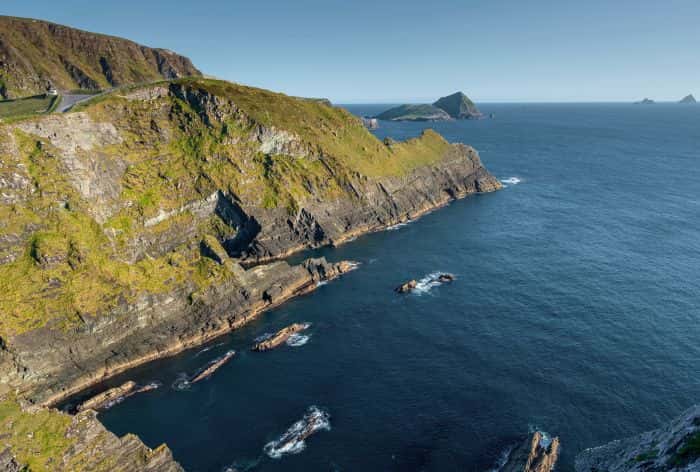
Stop #15 – Stunning Views from Different Viewpoints on Kerry Cliffs
Upon arrival, you’ll find a small parking lot with bathroom facilities, a cafe, and an admission stand. A ten-minute uphill walk will bring you to the cliff edge, where you’re treated to magnificent vistas along the cliffs and out toward the Atlantic Ocean.
Once at the cliffs, take your time to explore the multiple viewing areas, each offering a different perspective of the Cliffs of Kerry. During spring and summer, the cliffs and the rough waters below are teeming with birdlife.
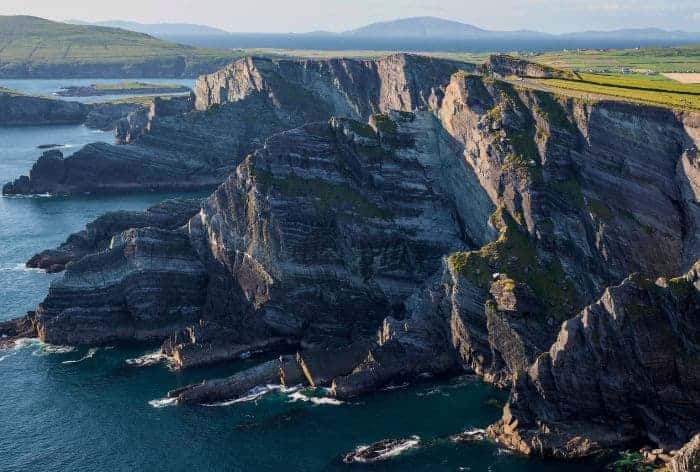
Stop #15 – Dramatic Scenery of Kerry Cliffs
Overall, the Kerry Cliffs provide an unforgettable experience, combining the beauty of the Irish countryside with a dramatic seascape that I am sure will leave you in awe!
Portmagee
Portmagee is a quaint village nestled on the Iveragh Peninsula and perched right at the edge of Valentia Island.
The village serves as a hub for tourists embarking on excursions to the nearby Skellig Islands, notably Skellig Michael, a UNESCO World Heritage Site renowned for its ancient monastic settlement.
Valentia Island
Another one of my favorite stops on the Ring of Kerry is Valentia Island accessible by bridge from Portmagee.
Valentia Island is famous for its ancient tetrapod footprints, which are among the oldest fossilized footprints in the world, providing valuable insights into the evolution of vertebrate life on Earth.
The island holds historical significance as it played a pivotal role in transatlantic communications, serving as the site of the first permanent telegraph cable connecting Europe with North America in the 19th century.
The views of the rugged cliffs are off the charts, and the lighthouse at the end of Cromwell Point adds to the picture-perfect setting.
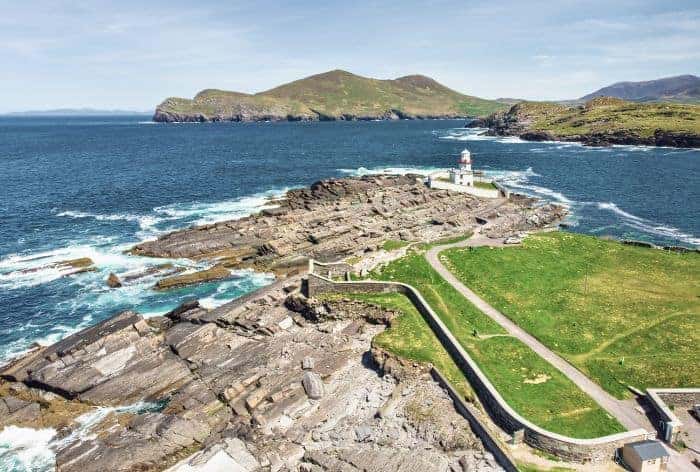
Stop #17 – Valentia Island with the Lighthouse at Cromwell Point
Cahergall Stone Fort
Cahergall Stone Fort is an ancient archaeological site located near Cahersiveen.
It is one of the best-preserved stone forts in the region, dating back to the early medieval period, estimated to have been built around the 6th or 7th century AD.
The fort is circular in shape and constructed entirely of dry stone masonry, without the use of mortar. It features thick stone walls, which enclose a central courtyard and provide evidence of skilled craftsmanship.
Cahergall Stone Fort is situated on a hilltop, offering panoramic views of the surrounding countryside and coastline. It is believed to have served as a defensive stronghold for its inhabitants, protecting against potential raids or invasions.
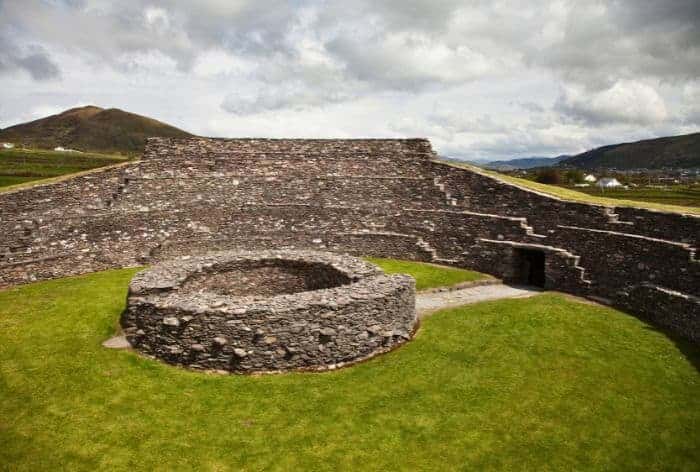
Stop #18 – Cahergall Stone Fort
Kells Bay Beach, House, and Gardens
Kells Bay Beach, House, and Gardens are located on the Iveragh Peninsula on the Ring of Kerry Drive.
Kells Bay Beach is a picturesque sandy beach along Dingle Bay perfect for a short walk to stretch your legs.
Kells House, an 18th-century mansion located near the beach, showcases elegant architecture and rich heritage. While not open to the public, you can appreciate its exterior and explore the surrounding gardens.
Kells Bay Gardens span over 17 acres and are renowned for their exotic plant collection, including palms, tree ferns, and bamboo.
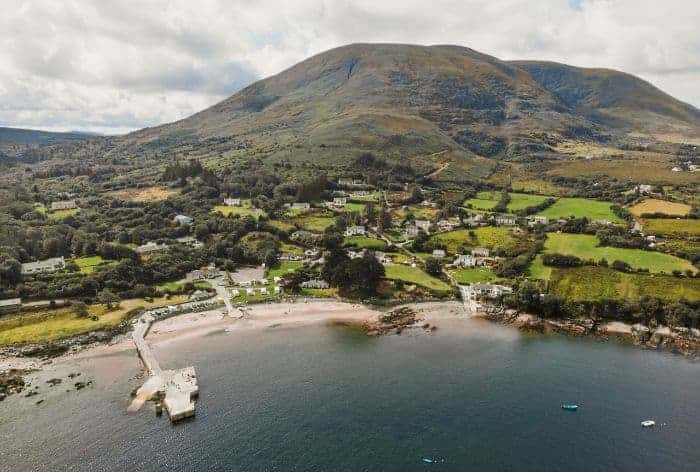
Stop #19 – Kells Bay Beach
Rossbeigh Bay Beach
The next stop on the Ring of Kerry is Rossbeigh Beach, a great place to take a break and stretch your legs.
It’s a 6-kilometer stretch of sandy coastline with views overlooking Dingle Bay.
Rossbeigh is known as one of the top beaches around, marked by its Blue Flag status which means the water is clean and safe for swimming, especially with lifeguards on duty during the summer.
Plus, there’s an annual horse riding festival on the beach at the end of summer!
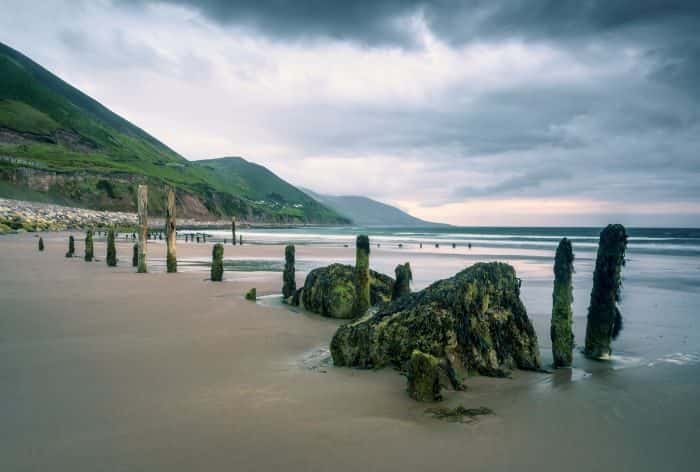
Stop #20 – Remains of a Jetty on Rossbeigh Beach
Kerry Woollen Mills
Next on the drive is Kerry Woollen Mills. It was founded in 1760 and is one of Ireland’s oldest woolen mills.
Throughout its long history, the mill has remained committed to producing textiles using traditional methods that are passed down from generation to generation.
The mill’s range of offerings includes blankets, rugs, scarves, and clothing, all crafted from locally sourced wool known for its durability, warmth, and natural qualities.
Kerry Woollen Mills offers guided tours of its facilities. During these tours, you can witness the weaving process firsthand.
Additionally, at the mill’s onsite shop, you can purchase blankets, rugs, scarves, and clothing, all crafted from locally sourced wool known for its durability, and warmth.
The Killarney Brewing and Distilling Company
As the drive around the Ring of Kerry comes to an end, what a perfect spot to finish it with a visit to the Killarney Brewing and Distilling Company where you can enjoy a diverse range of craft beers and spirits.
Founded in 2013, this company produces pale ales, stouts, lagers, and seasonal brews using traditional brewing techniques and locally sourced ingredients.
In addition to brewing, the company operates a distillery, crafting spirits such as gin, whiskey, and vodka. These spirits are meticulously made using traditional copper pot stills and carefully selected ingredients to ensure exceptional quality and distinct flavors.
You can join one of the guided tours of the facilities, and learn about the company’s history, brewing methods, and distillation techniques, which also include tastings of the brewery’s products.
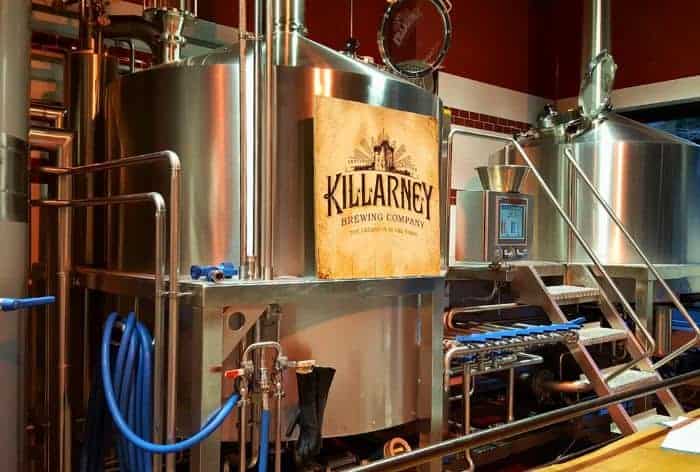
Stop #22 – Tour of the Killarney Brewing and Distilling Company
Intrepid Scout's Tips for Best Stops on the Ring of Kerry
In summary, the Ring of Kerry boasts quite a few noteworthy stops. Plan for at least two days to explore all the ones mentioned in this post.
However, if you’re short on time, check out the Perfect 1-Day Ring of Kerry Drive Itinerary for a condensed version of must-sees.
More Information About Ireland:
20 Must-See Sights and Attractions in Ireland (Your Essential Guide to the Emerald Isle)
14 Delicious Traditional Irish Foods You Must Try During Your Visit to Ireland
Perfect 10-Day Ireland Road Trip Itinerary (Detailed Map+Tips for Planning)
9 Amazing Things to Do in Killarney National Park (Maps+Tips)
Perfect 1-Day Ring of Kerry Drive Itinerary
14 Tips for First Visit to Dublin to Help You Explore Ireland’s Capital
2 Days in Dublin (15 Top Things You Can’t Miss)
16 Best Stops on the Dingle Peninsula Drive (map+detailed tips)
You Might Also Like:
82 Quotes About Ireland And the Irish Spirit Celebrating the Emerald Isle
102 Beautiful Irish Proverbs and Sayings Offering Timeless Lessons
92 Irish Blessings And Wishes Embracing Joy on St. Patrick’s Day
Did you find this useful?
Why Not Save Best Stops on the Ring of Kerry to Your Pinterest Board!
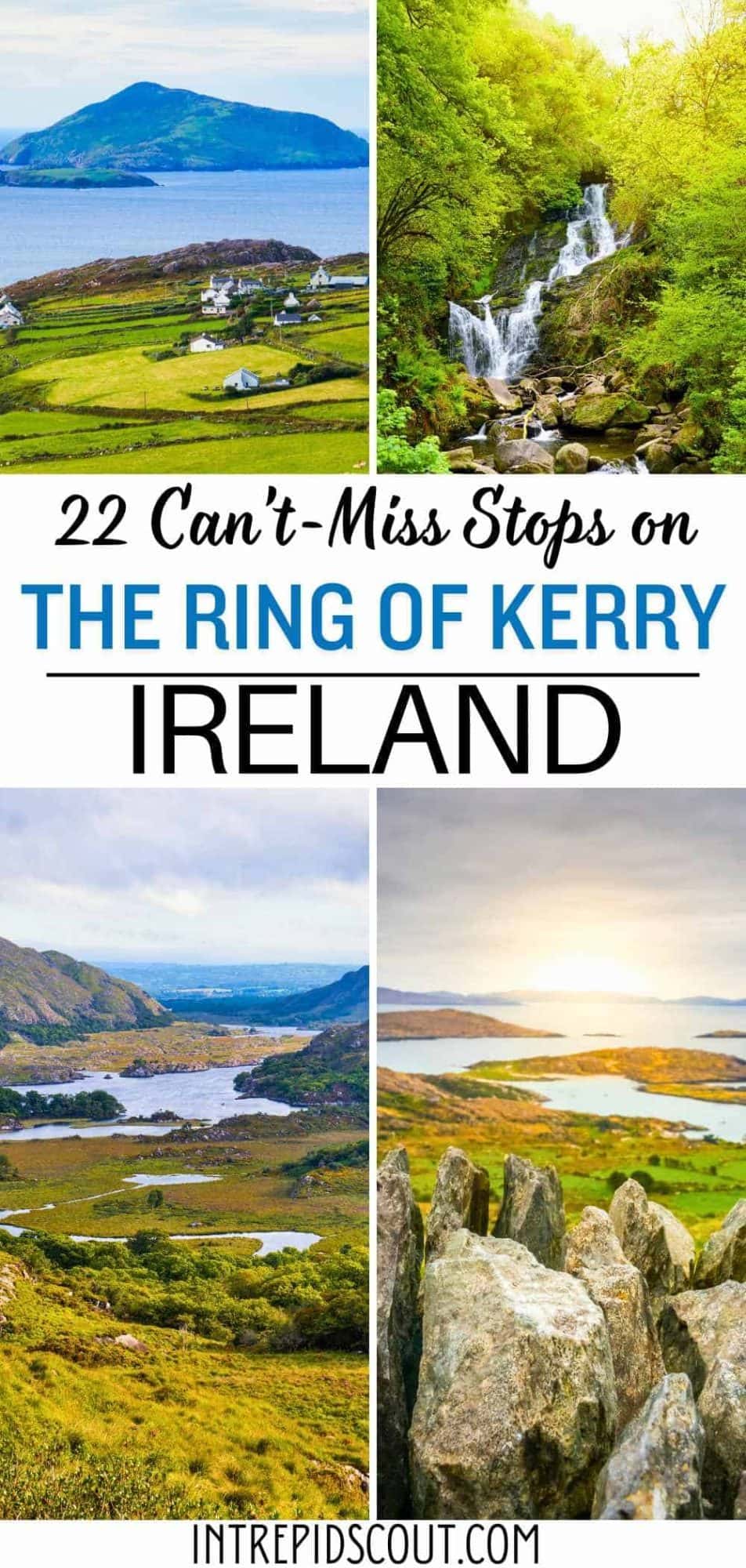
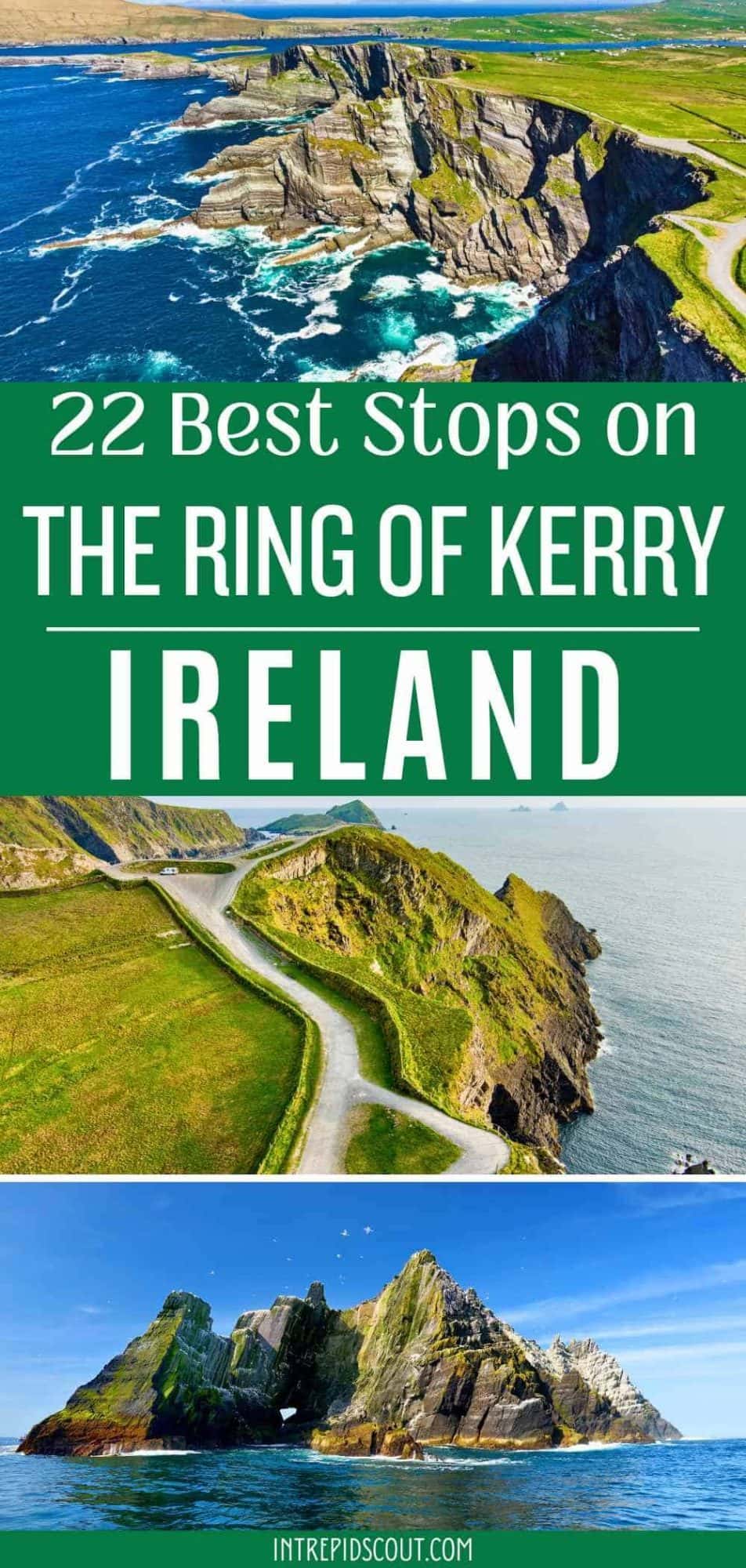
Now, It Is Your Turn, I Would Like to Hear Back from You!
Are you planning your trip to Ireland?
Please let me know! Drop me a quick comment right below!
Click on any of the images below to get inspired and to help you with the planning process for your trip to Ireland!
